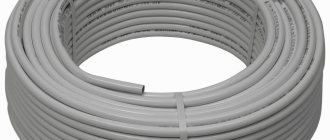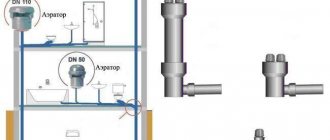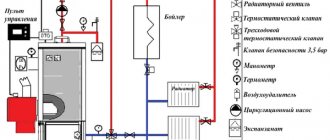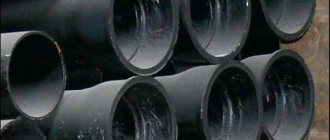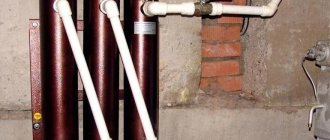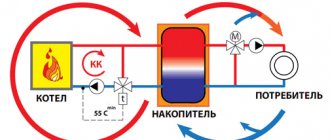PSUL tape
| Certificate of conformity PSUL | Fire declaration PSUL | Technical characteristics of PSUL | Price list for roofing seals |
PSUL tape is a universal elastic polyurethane sealant with the ability to self-expand.
Supplied in compressed rolls. During installation, after removing the packaging, it increases in size (expands up to 5 times). Thanks to its modified acrylic impregnation, self-expanding sealing tape is resistant to aging and retains its properties much longer than any other type of polyurethane sealant. Have questions? Call! WHOLESALE and Retail. Delivery to the regions.
We will send a photo or video review of the product you are interested in via WhatsApp, Viber, Skype or write to email!
On one side, the self-expanding tape has an adhesive layer, which significantly speeds up its installation. The versatility of PSUL lies in the fact that the tape can be used with all building materials: concrete, brick, steel, wood, plastic, etc. it sticks equally well to any surface. Pre-compressed sealing tape is lightweight and compact.
Buy PSUL in Moscow today at our offices and sales points or order on our website (find out the price by calling or contacting an online consultant). We will not only deliver the required amount of sealant, but will install it quickly and efficiently.
Description of bitumen tape for roofing
Bitumen tape is a sealant that is obtained from petroleum products; mountain tar has been in great demand since ancient times for construction and finishing. It was used in wood processing and creating mosaics from stones and shells. To obtain bitumen tape, materials such as oil, coal and shale are used. Regardless of its origin, the material presented is insoluble in water, so it has excellent water-repellent properties. Many also note the convenience of using vapor barrier film for roofing.
In the photo - bitumen tape:
The bitumen that is used to obtain the final result is amorphous, that is, in the solid state it exhibits the properties of a liquid. Thanks to its fluidity, convenient application of the material on various surfaces is achieved. Bitumen tape has excellent adhesive properties with various materials. Thanks to this, it can be used on concrete, stone, brick, metal and wood.
It’s clear how bitumen tape is obtained, but now you need to understand what this sealant is used for?
This popular construction project has a wide range of applications. Thus, you can purchase it to perform the following work: installation of soft roofing and bitumen shingles; sealing joints, seams and junctions: repair work and sealing holes in various roofing materials.
In the video - bitumen tape for roofing:
The advantages of bitumen tape include:
- It can be used on any surface: metal, concrete, brick, wood, soft roofing materials.
- The building material is able to withstand the influence of water. If moisture constantly affects the sealant, this will not affect its adhesive properties and polymerization.
- After installing the tape, there is no need to dry the contacting surfaces. Can be used immediately after it has rained.
- Bitumen tape has a long service life. It is 15-20 years.
- There is no corrosion when in contact with a metal surface. In addition, it will not occur during operation.
- Short setting period.
- There is no cracking or drying out, the possibility of deformation is insignificant. The tape is able to compensate for the displacement of adjacent structures.
- After applying the tape, the surface is not affected by fungi.
- The cost of building material is not high. In addition, the range includes products in various colors, so you can purchase a ribbon that perfectly matches the color scheme.
- Bitumen tape is able to withstand atmospheric conditions. It can be used even at air temperatures of -40 to +90 degrees.
- It is not destroyed under the influence of sunlight and chemical influences.
The bitumen tape has certain disadvantages, which include:
- The material can only be used for outdoor work. This is due to the fact that the tape has high toxicity.
- Bitumen tape is a flammable material.
- The tape becomes soft when exposed to high temperatures.
- If porous surfaces are being processed, then before applying the tape it is necessary to apply a special primer to them.
On the video, bitumen tape for roofing contains instructions for use:
Molded seals: brief description
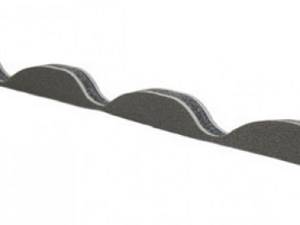
Molded seals are otherwise called figured or profile. They are tapes (strips) 1 or 2 m long, based on polyethylene foam. Such seals are chosen strictly in accordance with the type of roofing material - they must perfectly follow its relief. Seals for each type of corrugated sheet or metal tile differ.
Profile ridge seals for corrugated sheets or metal tiles perfectly isolate the joints of the roofing material and the ridge strip. They also support air exchange - they have holes for ventilation. However, we recommend providing additional ventilation of the under-roof space - for example, installing ventilation outlets on the roof.
Roofing mastic based on bitumen
The use of bitumen mastics in construction is undesirable, but without them, roofing materials are not fixed firmly enough. It is used for gluing strip roofs, strengthening the coating at joints and waterproofing.
Sometimes bitumen mastic is used in finishing work, for example, for gluing floor coverings such as parquet boards and linoleum. In such cases, mastic is not only an adhesive base, but also a waterproofing layer.
There are universal bitumen mastics, but even they cannot be used in all types of work. Based on the type of application, mastics are divided into the following types:
- cold - ready-made mass that can be used immediately after opening the package;
- water - considered one of the safest bitumen materials, but has a high cost;
- hot - before work, the material must be heated to a certain temperature indicated on the packaging.
In addition to ease of use, bitumen-based mastic has the following advantages:
- compatibility with most soft roofing materials, which allows it to be used on almost any roof;
- acceptable price;
- outstanding characteristics.
Despite the significant advantages of soft bitumen-based materials, they have a certain disadvantage: they cannot be used at certain temperatures. In addition, it is prohibited to lay bitumen mastic in high humidity and rain.
Most roofing and waterproofing coatings are not recommended for installation in winter. However, many manufacturers produce seasonal coatings, for example, Litkor polymer-bitumen tape. It is available in both winter and summer versions.
Which sealing tape should you choose for your home?
In order to choose the right self-adhesive tape, you should understand the differences between them:
Chimney sealing tape
This material is mainly used as part of the so-called soft chimney treatment. The tape “fixes” the chimney on the roof very well and does not allow soot and soot to get to the wrong places.
When purchasing a sealing tape for a chimney, you should definitely pay attention to the material from which it was made. Top quality products are made from aluminum or lead, among others.
It is also important that the outer layer of the tape is coated with a special paint, which makes the material resistant to changing weather conditions. It is recommended to choose models that use butyl glue - it is characterized by excellent adhesion and an instant bonding process. Therefore, the connection itself is very strong.
The last factor when choosing a ribbon will be its color. The stores sell sealing tapes in dozens of different colors, so there should be no problems choosing them to match the color of the roof. To improve the quality of the connection between the chimney and the roof, we can also apply a finishing strip to the tape, which will make the connection even stronger.
Scheme and nuances of using roofing tape
Bituminous tape is widely used for exterior roofing. Therefore, it is worth taking a closer look at the scheme of its application:
- Surface preparation - before gluing, clean the area to be treated from dust, dirt, mechanical particles, and old sealant. Compressed air can be used to remove dust. If there are oil or grease stains, it is allowed to use solvents that have a good effect on such stains. If you need to remove a layer of old sealant, you should use a sharp tool to pry it off, and then wipe the area with white spirit. For porous areas, you need to use a primer and subsequent drying.
- Prepare a self-adhesive blank in the form of a piece of tape.
- After removing the top protective layer, glue the workpiece to the roof section.
- Walk with a roller and check whether the workpiece fits tightly to the surface so that there are no air bubbles. When air appears under the tape, the tightness of the workpiece decreases, which affects the short life of the material.
- If you need to apply a lot of workpieces (for large roof areas to be treated), then this should be done by overlapping strips, maintaining a distance between layers of 1.5-3.0 cm. This gap helps prevent the penetration of water between the workpieces.
- Finally, treat the seams with white spirit. For additional sealing, you can use bitumen sealant.
If the material is stored for a long time at air temperatures below 0°C, it should be placed in a room where the air temperature corresponds to room temperature for 24 hours. After this, the tape is ready for use.
Why is it necessary to order installation from professionals?
— Our craftsmen improve their skills and take master classes from material manufacturers;
— Installation is carried out using prof. equipment and tools, in accordance with the instructions;
— The team is ready to start work within 3-5 days after receiving the application (depending on the season);
— More than 6 years of installation experience, more than 100 projects completed;
— When ordering material and its installation from us, you get additional discounts and a 1-year warranty.
ready to install all the materials presented on the site both in buildings under construction and in already built ones.
Rules of application
Before starting work using bitumen tape, you should know the rules for using this material:
- Preparation of the segment to be repaired - which must be thoroughly cleaned of dust and debris, and also dried well;
- For a high degree of adhesion of the bitumen tape to the surface, the surface should be primed, having previously degreased it (in the instructions for the tape, each manufacturer usually indicates the preferred type of primer material);
- The required piece of tape is measured and cut, and the protective film is removed from one side;
- Pressing the tape onto the surface to be repaired, it is rolled with a roller, achieving maximum air removal, which ensures reliable adhesion;
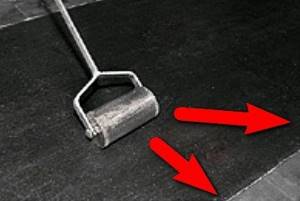
If repairs are necessary on a large area, the tape strips are laid overlapping, with each layer overlapping by 2-3 cm.
Attention! For additional waterproofing of the seams, they can be treated with bitumen sealant to obtain the maximum level of tightness.
If the air temperature at which the material was stored is below zero degrees Celsius, then before use it should be kept at room temperature for at least a day to restore all properties.
Overview of the modern market: universal and specialized tapes
Let's look at what types of bitumen tape the modern market offers today:
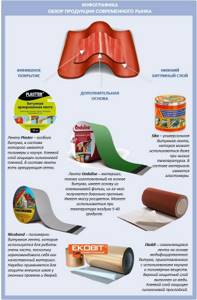
One of the most popular tapes is produced by Ecobit. This tape uses special bitumen, polymers and synthetic rubber. One important feature is that this tape is coated with copper, so it does not become overgrown with moss (although there is an aluminum option). On the other side, the tape is reinforced with polyester film.
Sika: for flexible bypass
Sika tape is good because it has a high-quality sticky bitumen component, which we also use at low temperatures. The whole secret is in elastomers - special modifying components. And on the outside of this tape is covered with silicone film.
Tips for choosing
The choice of seals on the market is very wide. When purchasing, experts do not recommend basing your purchase on price and purchasing cheap materials, since their properties and characteristics may differ from those declared. The choice of manufacturer also plays an important role. Products from trusted brands may be more expensive, but their quality and reliability meet all standards. You can also check certificates and other documentation if you wish.
An important point is the correct choice of the type of material that is planned to be used for roofing work.
If installation is carried out in cold weather, it is recommended to use profile products. In the summer, it would be advisable to use self-expanding models on a self-adhesive basis.
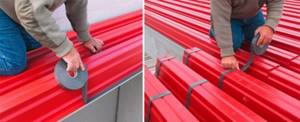
For information on the use of roofing seals, see the following video.
- Designed to protect rafter legs or continuous flooring from the penetration of rain and melt water through the places where counter-lattens and sheathing are fastened with nails.
- It is glued on top of the film along the rafter legs.
- Must be used on roofs of complex shapes and roofs with a small angle of inclination (less than 22 degrees).
- Installation should be carried out at an ambient temperature of -5 o C - +40 o C.
- Retains all its properties at temperatures -40 o C - +80 o C
Advantages of use and features of the material
This material is a self-adhesive fabric that, when used, provides a highly effective waterproofing layer. Light weight, high degree of elasticity and strength are not the last advantages that are characteristic of bitumen tape.
The structure of this material is multilayer, which consists of:
- The inner layer is modified bitumen, which contains rubber and polymers;
- The outer layer is a thin sheet of copper and aluminum, which provides reliable protection from the influence of external negative factors.
The features of bitumen roofing tape include:
- Compatible with a large number of types of building materials (concrete, stone, wood, ceramics, etc.) with a high level of adhesion;
- Installation does not require specific skills, and there is no need to use specialized equipment;
- Wide temperature range of application;
- The optimal alternative to complex repairs in the most inaccessible places;
- There is no need to use open fire, which means a high degree of safety during work, and the ability to use the material for repairing flammable coatings;
- It is not destroyed by the sun, water and chemicals;
- The presence of self-healing ability (not all manufacturers endow the material with such properties);
- A variety of colors, which makes it possible to use the tape without additional finishing.
Bitumen-polymer joining tapes have found wide application in construction, and can be used for such purposes as:
- Roof waterproofing;
- Foundation sealant;
- Waterproofing system for water supply joints;
- Connections between the roof and vertical structures;
- Ceilings and openings, as well as sealing cracks and joints;
Sealant for corrugated sheets
| Type of corrugated sheet | type of seal | thickness mm. | unit length, m. | number of pieces/meter. in the box |
| H153 | upper | 30 | 0,84 (0,9) | 50 |
| lower | 30 | |||
| H114 | upper | 30 | 0.75 | 50/37,5 |
| lower | 30 | 0.75 | 80/48 | |
| H100 | upper | 30 | ||
| lower | 30 | |||
| N 75 | upper | 30 | 0.75 | 90/67.5 |
| lower | 30 | 0.75 | 150/112.5 | |
| N 60 | upper | 30 | 0.845 | 100/84.5 |
| lower | 30 | 0.845 | 150/126.8 | |
| N 57 | upper | 25 | 0.75 | 100/75 |
| lower | 25 | 0.75 | 170/127.5 | |
| N 50 | upper | 25 | 0.88 | |
| lower | 25 | 0.88 | ||
| NS 44 | upper | 25 | 1 | 130/130 |
| lower | 25 | 1 | 200/200 | |
| NS 40 | upper | 25 | ||
| lower | 25 | |||
| NS 35 | top/bottom | 25 | 1 | 250/250 |
| MP 35 | upper | 25 | ||
| lower | 25 | |||
| NS 25 | upper | 20 | 0.99 | |
| lower | 20 | 0.99 | ||
| NS 21/S21 | top/bottom | 20 | 1 | 400/400 |
| MP 20 | upper | 20 | 1.1 | 300/330 |
| lower | 20 | 1.1 | 500/550 | |
| C8 | top/bottom | 20 | 1,15 | 700/805 |
Other products from the category “Adhesives, foam, sealants”
Adhesive for extruded polystyrene foam (XPS) and foam
Roofing sealing tape Tytan 0.10*10m
Bitumen varnish
We deliver throughout St. Petersburg and the Leningrad region! A small geography of settlements to which we successfully deliver orders: Kirovsky district, Vsevolozhsky district, Gatchina district, Lomonosovsky district, Kolpinsky district, Priozersky district, Vyborg district, Kurortny district, Sestroretsky district, Tosnensky district. Rybatskoye, Ust-Izhora, Pontoonny, Saperny, Kolpino, Telmana, Sablino, Pavlovo, Otradnoye, Mga, Mikhailovskoye, Apraksin, Nikolskoye, Krasny Bor, Porkuzi, Kirovsk, Sinyavino, Murmansk highway, Putilovo, Priladozhsky, Nazia, Ulyanovka, Shushary, Pushkin, Pavlovsk, Romanovka, Metallostroy, Slavyanka, Gatchina, Krasnitsy, Cable-stayed bridge, Kommunar, Utkina Zavod, Red Star, Rapids, Novosaratovka, village. named after Sverdlov, Sertolovo, Roshchino, Zelenogorsk, Solnechnoe, Sestroretsk, Vyborg Highway, Agalatovo, Black River, Pargolovo, Levashovo, Shuvalovo, Beloostrov, Pesochny, Repino, Komarovo, Oselki, Vaskelovo, Lembolovo, Orekhovo, Gruzino, Toksovo, Kuzmolovo, Yukki, Vsevolozhsk, Lisiy Nos, Shlisselburg, Borisova Griva, village. them. Morozova, Danube, Gardens, Rakhya, Vaganovo, Lake Ladoga, Razmetelevo, Myaglovo, Koltushi, Aspen Grove, Volosovo, Thais, Fornosovo, Antropshino, Alexandrovskaya, Kipen, Ropsha, Razbegaevo, Strelna, Peterhof, Lomonosov, Lebyazhye, Vyritsa, Tosno, Ushaki, Villozi, Gorelovo, Pine Glade, Volodarsky, Kupchino, Road of Life, Pargolovo, Olgino, Bugry, Devyatkino, Murino, Aviagorodok, Staropanovo, Rzhevka, Bolshevikov, Shcheglovo, Kornevo, Krasnaya Gorka, Koltushi, Yanino, Voeykovo, Samarka, Rakhya , Kokkorevo, Gannibalovka, Petrokrepost, Murm.sh.38km, Novosaratovka, Orangereika, Nevsky Forest Park, Rapids, Gribnoye, Priladozhsky, Nazia, Mikhailovsky, Apraksin, Dachnoye, Mountains, Kelkolovo, Nurma, Turyshkino, Sologubovka, Pavlovo, Saperny, Pella, Yam-Izhora, Ust-Izhora, Pukholovo, Petroslavyanka, Pontoon, Nikolskoye, Mishkino, Sapernoye, Krasny Bor, Popovka, Alexandrovskaya, Pavlovsk, Pyazelevo, Fedorovskoye, Maryino, Kobralovo, Pokrovskaya, Vyarlevo, Reppolovo, Verevo, Pudost, Voskresenskoye, Malye Kolpany, Lyadino, Susanino, Krasnitsy, Siversky, Vyra, Kurovitsy, Toriki, Annino, Telezi, Ropsha, Kipen, Gostilitsy, Cheremykino, Housewarming, Volodarskaya, Peterhof, Maryino, Sanino, Sashino, Gostilitskoye highway, Oranienbaum, Malaya Izhora, Bronka . , Novozhilovo, Snegirevka, Petrovskoye, Vesnino, Kuyvozi.

